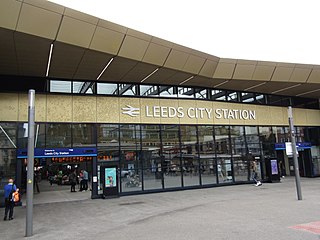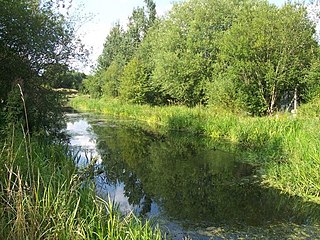
Leeds railway station is the mainline railway station serving the city centre of Leeds in West Yorkshire, England. It is located on New Station Street to the south of City Square, at the foot of Park Row, behind the landmark Queens Hotel. It is one of 20 stations managed by Network Rail. As of December 2023, it was the busiest station in West Yorkshire, as well as in Yorkshire & the Humber, and the entirety of Northern England. It is the second busiest station in the UK outside of London, after Birmingham New Street.

Maltby is a former mining town and civil parish in the Metropolitan Borough of Rotherham, South Yorkshire, England. It was historically in the West Riding of Yorkshire. It is located 6 miles (10 km) east of Rotherham and 10 miles (16 km) north-east of Sheffield. It forms a continuous urban area with Hellaby, separated from the rest of Rotherham by the M18 motorway. It had a population of 16,688 at the 2011 Census.

Rossington is a civil parish and former mining village in the Metropolitan Borough of Doncaster in South Yorkshire, England and is surrounded by countryside and the market towns of Bawtry and Tickhill.

The North Tyneside Steam Railway and Stephenson Steam Railway are visitor attractions in North Shields, North East England. The museum and railway workshops share a building on Middle Engine Lane adjacent to the Silverlink Retail Park. The railway is a standard gauge line, running south for 2 miles (3.2 km) from the museum to Percy Main. The railway is operated by the North Tyneside Steam Railway Association (NTSRA). The museum is managed by Tyne and Wear Archives and Museums on behalf of North Tyneside Council.

The Elsecar Heritage Railway (EHR) is located on the southern part of the former South Yorkshire Railway freight-only branch which ran from Elsecar Junction on its Mexborough to Barnsley Line.

Woodhouse railway station serves Woodhouse and Woodhouse Mill in Sheffield, South Yorkshire, England. The station is 5.25 miles (8 km) east of Sheffield station on the Sheffield to Lincoln Line.

Woodlesford railway station serves a suburban village of Woodlesford and a town of Rothwell in West Yorkshire, England. It lies on the Hallam Line and the Pontefract Line, 6 miles (9.7 km) south of Leeds.

Pontefract Tanshelf railway station is the most central station in the town of Pontefract, West Yorkshire, England, and serves Pontefract Races, the racecourse located just down the street from the station. It lies on the Pontefract Line operated by Northern and is 8 miles (13 km) east of Wakefield Kirkgate. In the days of coal mining in the Pontefract area, the station served the needs of the local workforce with regular and frequent services timed for the beginning and the end of mining shifts. The station is the closest to the former Prince of Wales Colliery which closed in August 2002. The station serves Beechnut Lane, the home ground of Pontefract Collieries F.C.

Knottingley railway station serves the town of Knottingley in West Yorkshire, England. It lies on the Pontefract Line, operated by Northern, and is 16 miles (26 km) south east of Leeds railway station.

Dodworth railway station serves the village of Dodworth, in the Metropolitan Borough of Barnsley, South Yorkshire, England. The station is 2 miles 71 chains (4.6 km) west of Barnsley on the Penistone Line between Huddersfield and Sheffield.

The Middleton Railway is the world's oldest continuously working railway, situated in the English city of Leeds. It was founded in 1758 and is now a heritage railway, run by volunteers from The Middleton Railway Trust Ltd. since 1960.

Caphouse Colliery, originally known as Overton Colliery, was a coal mine in Overton, near Wakefield, West Yorkshire, England. It was situated on the Denby Grange estate owned by the Lister Kaye family, and was worked from the 18th century until 1985. It reopened as the Yorkshire Mining Museum in 1988, and is now the National Coal Mining Museum for England.

Netherton is a village in the City of Wakefield metropolitan borough of West Yorkshire, England. It lies about 4 miles south-west of Wakefield, 3 miles south of Ossett and 1 mile south of Horbury. The village is in the Wakefield Rural ward of Wakefield Metropolitan District Council. The village name is shown on map "Dvcatvs Eboracensis pars occidentalis" from 1646.

Outwood is a district to the north of Wakefield in West Yorkshire, England. The district is centred on the A61 Leeds Road south of Lofthouse. It grew up as a pit village and was only a small settlement until the 1970s, when construction of new houses caused it to grow and merge with neighbouring settlements such as Wrenthorpe and Stanley. In 2001, it had a population of 7,623.
Ellistown is a village about 2 miles (3 km) south of Coalville in North West Leicestershire, England. It is named after Colonel Joseph Joel Ellis who died in 1885. The population from the 2011 census was included in the civil parish of Ellistown and Battleflat.

The Greasbrough Canal was a private canal built by the Marquess of Rockingham to serve his coal mining interests in and around the village of Greasbrough, near Rotherham, South Yorkshire, England. It opened in 1780, and the Newbiggin branch was built some time later. The main line to Greasbrough closed in 1840 with the coming of the Sheffield and Rotherham Railway, and the canal ceased to carry commercial traffic during the First World War. Most of it has been filled in, but a small section near the River Don Navigation remains in water.

Robin Hood is a village in the City of Leeds in West Yorkshire, England. It is close to the City of Wakefield boundary and is situated between Leeds and Wakefield as well as being close to Rothwell and Lofthouse.

Middleton Junction railway station was an early junction station on the Manchester and Leeds Railway, it opened when the branch to Oldham opened in 1842.
Newthorpe, Greasley and Shipley Gate railway station was a railway station which served the villages of Newthorpe, Greasley and Shipley Gate on the border of Derbyshire and Nottinghamshire. It was opened by the Great Northern Railway on its Derbyshire Extension and closed in 1963.

Copmanthorpe railway station served the village of Copmanthorpe, North Yorkshire, England from 1839 to 1959 on the York to Normanton line. The line also became part of the East Coast Main Line at various periods. The station was moved and substantially rebuilt halfway through its working life.



















